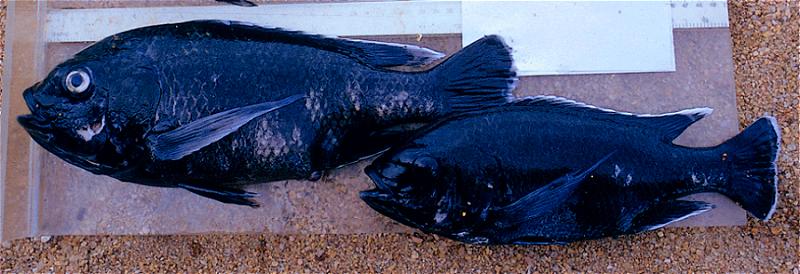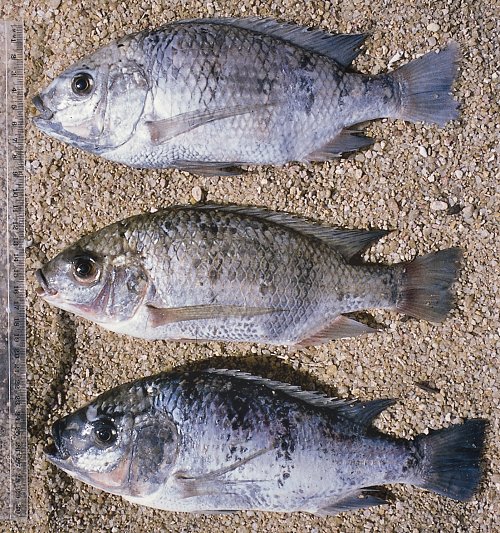
Territorial males of Oreochromis (Nyasalapia) lidole (photo © by George Turner)

Territorial males of Oreochromis (Nyasalapia) lidole (photo © by George Turner)
Oreochromis (Nyasalapia) lidole (Trewavas)
Text and photos by Guest Author: Prof. George F. Turner (Bangor University, UK)
and Michael K. Oliver
This is one of the three 'Chambo' species endemic to Lake Malawi. The three species are believed to be more closely related to each other than to other tilapia species (Sodsuk et al., 1995), and have probably evolved within the lake. Like other species of the subgenus Nyasalapia, males develop long branched genital 'tassels' that serve as egg dummies (as illustrated for O. (N.) squamipinnis). Territorial male O.lidole are jet black, with a white dorsal fin margin (see photo above).In the photo below taken at Cape Maclear, of immatures about 25 cm (10 inches) total length, the upper fish is O. squamipinnis, the middle one O. karongae and the lower one O. lidole. The O. lidole has the typical dark grey colour of its species, with long jaws and big, square operculum. Unlike the other two species, we found little geographical variation in morphology in O. lidole (Turner & Robinson, 1991). (Continued after photo)

Comparison of (top to bottom) Oreochromis squamipinnis, O. karongae, and O. lidole
captured at Cape Maclear (photo © by George F. Turner)
Oreochromis lidole is believed to be the chambo species most adapted to deep water and feeding in the water column. It reaches a maximum size of around 37cm (14½ inches) total length. They feed on algae, detritus and zooplankton (Turner et al., 1991).
The breeding season runs from September to March, peaking from October to February. Like other Oreochromis, they are maternal mouthbrooders. Males dig large spawning pits at depths of 17 metres (50 feet) or more. The pits are immense: up to 3 metres (10 feet) in diameter, with central platforms as much as 75cm (2½ feet) wide.
Trewavas (1983: 477-8) provided some additional details on breeding:
"No difference in size has been found between the sexes.... Breeding males become black with white margins to dorsal and often also caudal and anal fins. The female retains the colour of the non-breeding fish, but with the dark bars less well marked. Breeding starts at about 28 cm TL and an age of three years.... The spawning arenas are in deeper water ... off clean sandy or rocky shores."The chambo are the most valuable food fishes in Malawi, but populations collapsed in the 1990s as a result of overfishing. In addition to Lake Malawi, O. lidole is also found in two small crater lakes located some 8 to 25 km north of Lake Malawi, L. Kingiri and L. Chungruru. These lakes may have been populated with this species at a past period of higher lake levels, but they may have been introduced by humans.
O. lidole has numerous common names around southern Lake Malawi, where it is common, including the general name Chambo (applied to many tilapias), Lidole, Galamulu, Lolo, Chinkulu, Zeya Dole, Kasawala, and Kasawala Dole. Some of these names are applied only to certain life stages, or to one sex, or to other species as well — a good example of why scientific names are needed.

|
Suggested citation of this page: Turner, G.F., and M.K. Oliver (2003) Oreochromis (Nyasalapia) lidole (Trewavas). http://malawicichlids.com/mw10001b.htm. In: "The Cichlid Fishes of Lake Malawi, Africa" (M.K. Oliver, webmaster), http://malawicichlids.com. Accessed [date]. | |||
| Jointly authored page first posted: 27 February 2003
Web Author: M. K. Oliver, Ph.D. Copyright © 1997-2021 by M. K. Oliver, Ph.D. - ALL RIGHTS RESERVED |